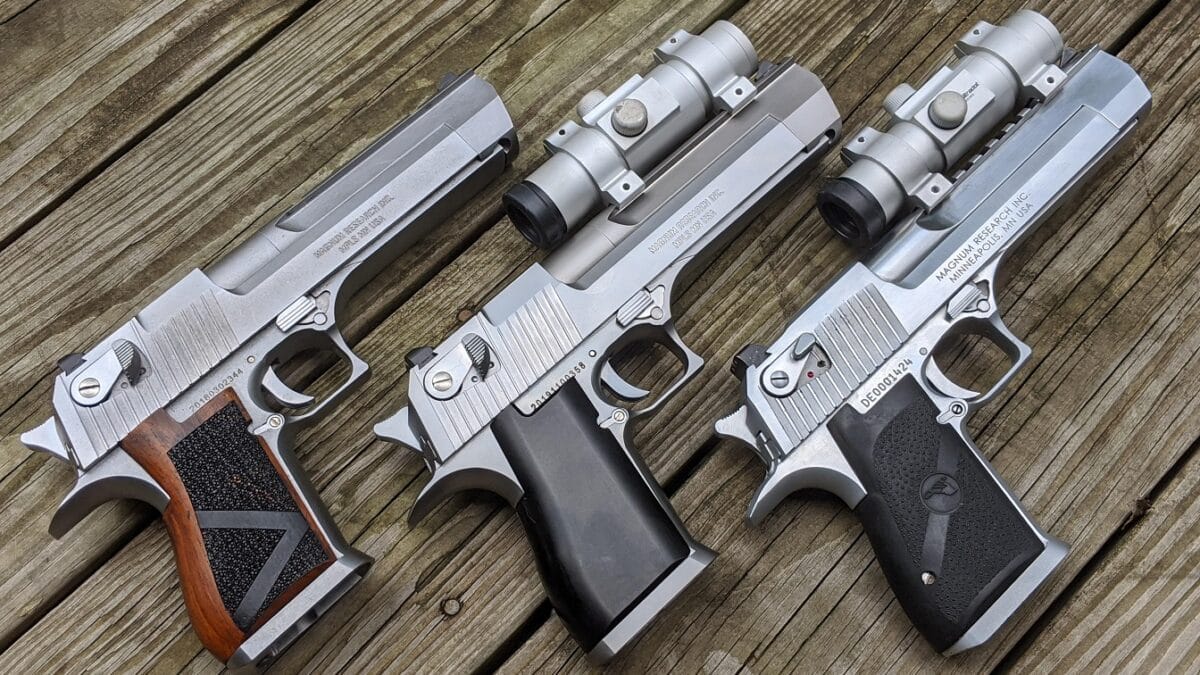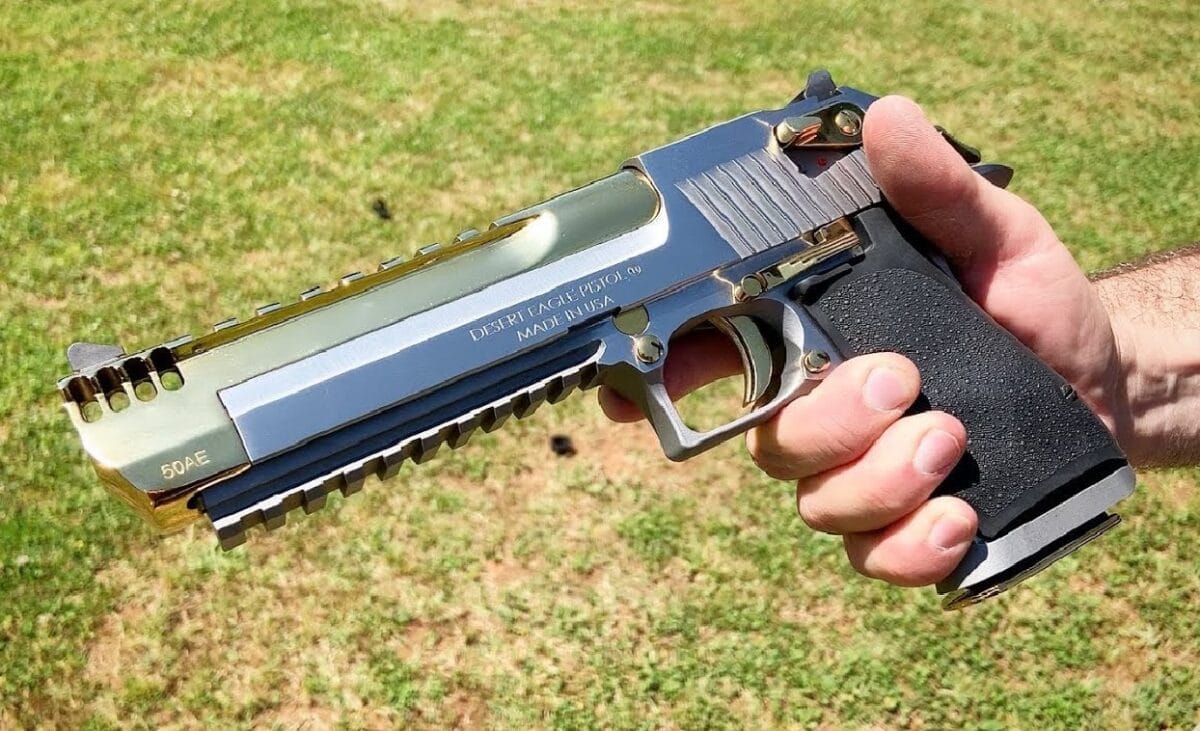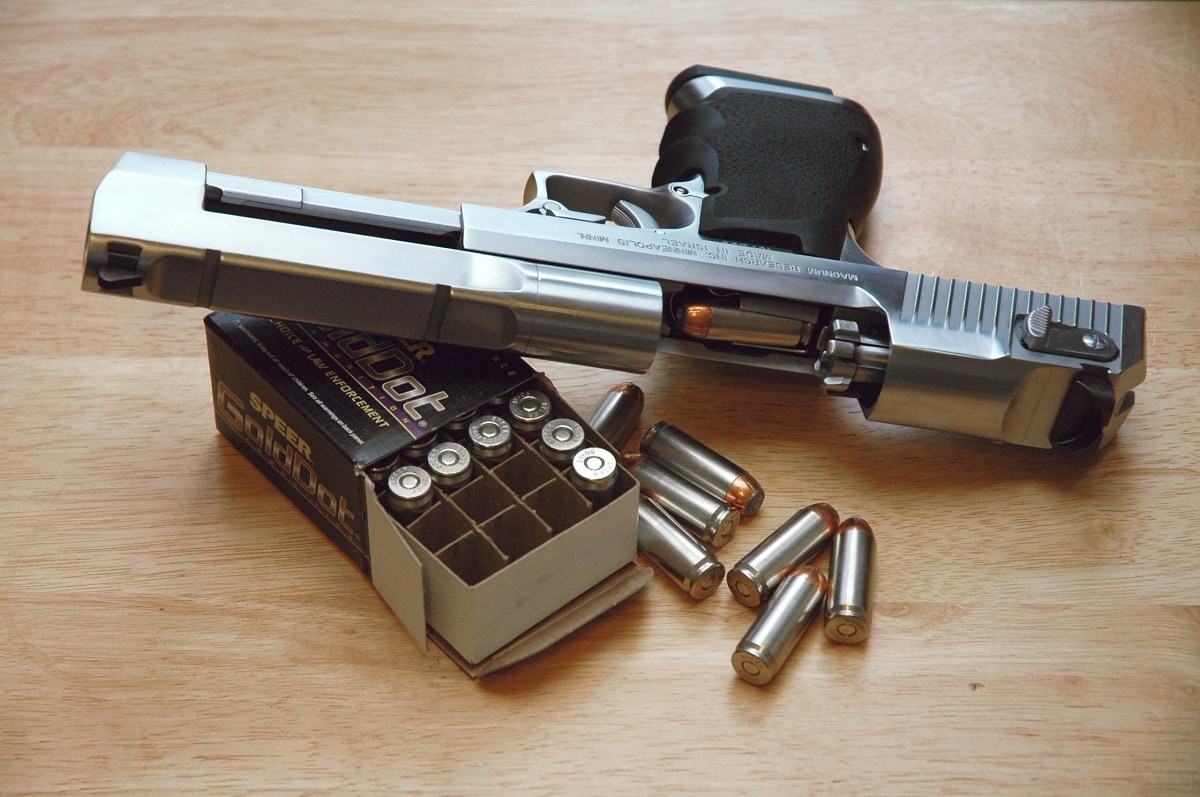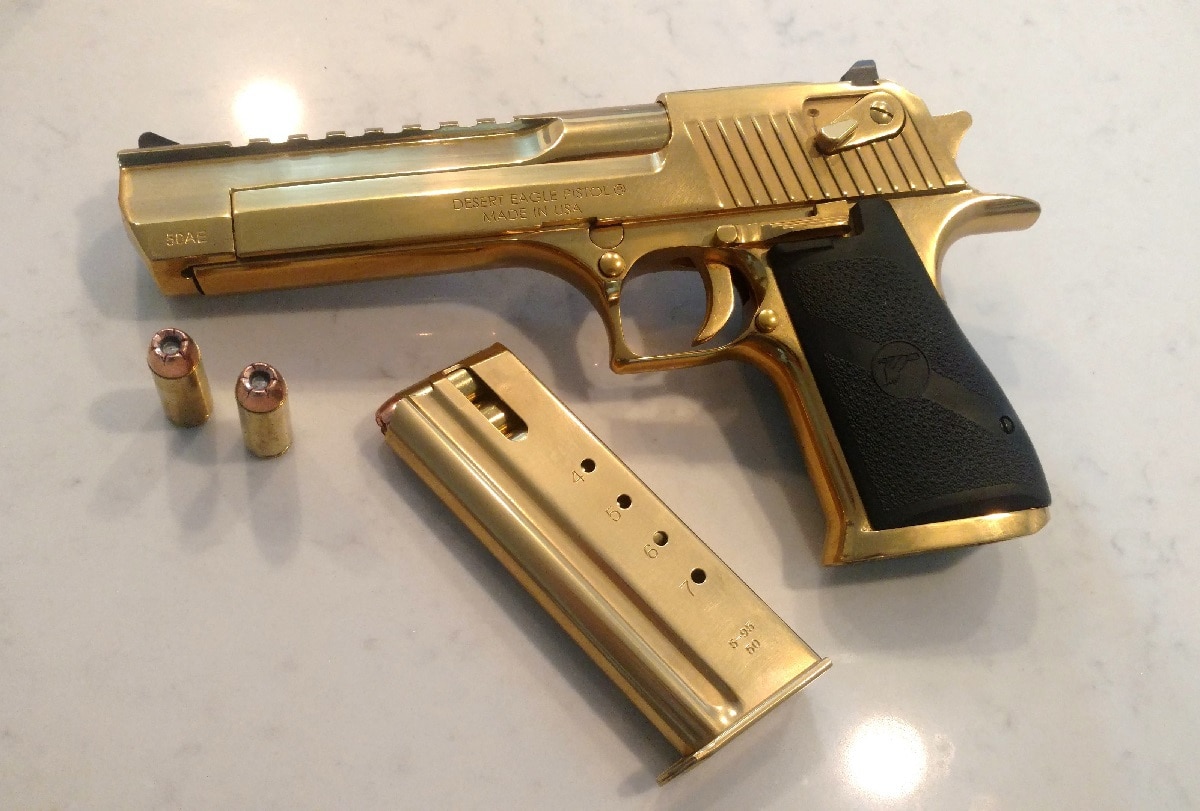Commando (1985); Red Heat (1988); Cliffhanger (1993); Demolition Man (1993); and roughly 36 other major motion pictures. This is not the filmography of any flesh & blood action movie star. Rather, we’re talking about the filmography of the enormous Desert Eagle .44 Magnum.
A Brief History of the Desert Eagle
A lot of people are under the impression that the Desert Eagle is an Israeli invention, much like the Uzi submachine gun and the Galil rifle. But that is not quite the case. As Chris Eger noted in a September 2021 article for Guns.Com:
“Although many think the Desert Eagle was an Israeli gun, it came from Minnesota with Magnum Research. With work on the large-framed semi-auto icon going back as far as the 1970s, Bernard White in 1983 filed a 14-page patent for the design of a gas-operated pistol with a rotating bolt and twin recoil springs. A short-stroke piston in a gas cylinder under the fixed barrel drives the slide to the rear.
“Lacking manufacturing capabilities, the design was shopped around with Israel Military Industries finishing it and putting it into production for Magnum Research.
“When the original Desert Eagle Mark I headed to market in 1984, it was advertised as ‘invented, patented and marketed’ by Magnum Research and ‘manufactured and developed’ by IMI.”
That noted, with that IMI connection factored in, one cannot help but wonder whether Sacha Baron Cohen was aiming for deliberate irony when he picked up a Desert Eagle for the infamous “Make my day, Jew,” scene in his 2006 comedy smash hit Borat, or if that was mere crazy coincidence.
The .357 Magnum chambering – with a 10 + 1 round capacity – was first out of the proverbial starting gate, followed in 1986 by the .44 Magnum version and a 9 + 1 capacity. (The .429 DE and .50 AE chamberings are a separate story of their own.)
What made the Desert Eagle such a big deal is that shooters could now choose a semiautomatic weapon that could safely chamber and fire calibers that had previously been the near-exclusive realm of revolvers. Sure, there had been non-conventional Magnum cartridges designed for autopistols, such as the AMP .44 Auto Mag and the .475 Wildey Magnum. But the Desert Eagle actually used the mainstream Magnum calibers.
Personal Shooting Impressions
Back on Labor Day weekend months back, I was vacationing in my childhood hometown of Los Angeles, and I decided to go with a buddy to one of my favorite downtown stomping grounds, the Los Angeles Gun Club. When looking over LAGC’s rental gun options, I was a tad surprised to see there were not one, not two, but three Desert Eagles to choose from. Surprised, I say, because when LAGC first opened in 1990, the facility’s then-manager refused to include the Desert Eagle as a rental choice. It was, in his words, “a $900 piece of junk.”
I just had to indulge my curiosity, as I hadn’t fired one of these monstrous pistols since my late teens. In true Bon Vivant fashion, I went with the fanciest-looking specimen, one with a hard chrome finish. I initially planned to buy 50 rounds to split between myself and my buddy – a fellow USC alumnus and federal law enforcement veteran – but right then and there, the LAGC staffer warned me, “Are you sure you want 50 rounds? It’s a jammer!”
Heeding that warning, and being ever mindful of the ridiculous cost of ammo these days, especially for larger calibers, I settled for 30 rounds (20 for myself, 10 for my friend). And boy am I glad I did; those additional 20 rounds would have been mere additional frustration.
In a word: Jamamatic.
My shooting buddy and I were lucky if we could coax even three rounds out of this fancy-pants pistol between jams, failures to go into battery, double-feeds, and worst of all, two extraction failures that so thoroughly locked up the gun, it took a Herculean amount of force to work the slide and clear the spent cartridge case. The on-duty range safety officer informed us that these were common problems for all three of their Desert Eagle rental guns.
That said, the Desert Eagle was accurate. I hit ten nicely clustered head shots on the bridge of the ICE-QT target at 21 feet, and ten well-centered hits in the 5-zone of the target torso at 50 feet, with only one of those rounds straying outside the tiebreaking 5x-ring.
Trigger pull was decent, while the slide stop lever and magazine release button were fairly easy to manipulate in spite of the Eagle’s size. The slide-mounted safety – which is something you normally expect to see on a traditional double-action auto pistol, as opposed to a typical single-action auto – was decidedly un-ergonomic.
Bottom Line
Some shooters I know in person, and others whom I have met on social media, insist their Desert Eagles function flawlessly. But a good number of others’ experiences mirror my own. So, if you can afford to cough up four figures to own a piece of hardware that will help you look like a cinematic badass, hey, more power to ya. Me? I’m spending the rest of my range-budget bucks elsewhere.

Desert Eagle. Image Credit: Creative Commons.

Image: Creative Commons.

Mark XIX Desert Eagle pistol with a box of Speer 325-grain .50 AE ammunition.
MORE: The F-35 Now Comes in Beast Mode
MORE: Why the U.S. Navy Tried to Sink Their Own Aircraft Carrier
Christian D. Orr has 33 years of shooting experience, starting at the tender age of 14. His marksmanship accomplishments include: the Air Force Small Arms Ribbon w/one device (for M16A2 rifle and M9 pistol); Pistol Expert Ratings from U.S. Customs & Border Protection (CBP), Immigration & Customs Enforcement (ICE), and the Federal Law Enforcement Training Center (FLETC) Criminal Investigator Training Program (CITP); multiple medals and trophies via the Glock Sport Shooting Foundation (GSSF) and the Nevada Police & Fires Games (NPAF). Chris has been an NRA Certified Basic Pistol Instructor since 2011. In his spare time, he enjoys (besides shooting, obviously) dining out, cigars, Irish and British pubs, travel, USC Trojans college football, and Washington DC professional sports.

